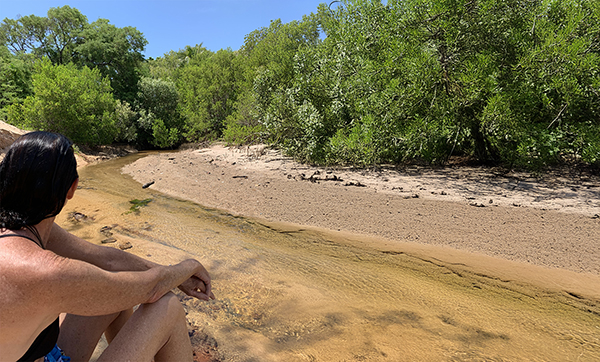Carrie and I had never set foot near Skipper Creek again after Melinda lost her life there forty-one years ago.
We had talked about going many times—to sit, to meditate—but we never made it. I think we were always too sickened by the trauma of her murder, the legal case that followed, and the acquittal. Avoidance became a self-preservation tactic, a way to protect our mental and emotional health.
Six months prior, Carrie and I had planned a visit. We were drawn to make a kind of pilgrimage to the island, hoping to finally find a sense of resolve, healing, and closure.
The last time we had physically been at the Skipper Creek end of Scotsman’s Bay, we were teenagers. Now, in our mid-fifties, we were returning to the murder site.
Joining us was our lifelong friend, Anna—three island sisters supporting each other in remembering, grieving, and trying to move beyond the heavy loss we had carried for forty-one years.
The emotions that fester when a loved one is suddenly murdered are well-documented now. An unresolved case can have profound and lasting effects—intense grief, disrupted relationships, persistent anxiety, feelings of powerlessness, social isolation, and a constant sense of unfinished business. This crime remains unsolved. The prosecution failed, the case files were conveniently lost, and the records were locked away to protect the guilty minor.
Carrie and I had only visited Mel’s grave two or three times before, when our grief was still raw. But now, after forty years, we had returned—to visit her grave, the murder site, and the Granite Island Museum.
Before departing the mainland on the car ferry, we stopped at the cemetery. It was an important moment, one that set the tone for our journey. Time had softened the sharp edges of anger, allowing us to experience ‘the different story’—the now story. The grief in Scotsman’s Bay had been collective. Everyone who knew the White family had felt the intense shock and sorrow of losing Melinda, a bright, beautiful young woman. Seventeen years old. Her life had barely begun.
The twelve-hour drive up the coast to Granite Island passed quickly as Carrie, Anna, and I caught up, sharing stories of our lives now, so different from when we last stood together on that shore. We took turns driving and arrived on the island on December 27, 2024. After checking into our accommodation, we prepared for our week together. First and foremost, we had come for Mel.
When we arrived at the old Scotsman’s Bay schoolhouse—now the island museum—we were greeted by a small, silver-haired woman named Helen, a local volunteer. To our surprise, she was a longtime friend of the White family and had lived on the island for over forty years.
Carrie and Helen spoke for a long time about the good old days before the tragedy, and particularly about what she remembered of the murder.
Another volunteer, Pat, managed the museum’s history library and official island records. I had spoken to her over the phone while gathering information for Carrie’s family. The museum was eager to obtain copies of any research or documents related to Mel’s murder. I promised Pat that once we completed the Office of Information Commissioner’s review, I would send them everything we uncovered.
We had brought a small brass plaque, made by Ron’s work colleagues, to honor Mel’s tragic story. With the museum’s permission, we planned to place it in the garden beside the Evidence Rocks.
The two large boulders, sitting at the corner of the library building, had been excavated from the Skipper Creek inlet during the murder investigation. It was a significant revelation to learn that they had been moved from the old island police station to the museum. We first learned of their existence through a conversation with Pam.
During our previous visit in 2023, for a reunion of past island residents from the 1970s and 80s, we had seen these rocks for the first time.
We asked Pam if she had a hammer to secure the plaque. It was welded onto a metal stake, meant to be driven into the ground near the Evidence Rocks. We assumed the sandy soil would be soft, but instead, we hit hard, dry earth. Pam first returned with a heavy-handled knife to use as a hammer, but it failed. She disappeared again, searching for something more effective.
As we waited, we spoke about the symbolism of the knife—about severing and healing. When Pam returned, she carried an unusual metal object. At first, I thought it was some kind of anchor, but on closer inspection, it looked eerily like ankle shackles.
The shackles of time, I thought.
Fittingly, it was this object that helped us secure the plaque into the ground. Carrie hammered it in while Anna and I encouraged her. It was a moment. When the plaque was finally set in place, next to the Evidence Rocks, we stood arm in arm, remembering our island sister. Tears welled. We knew how sacred this moment was.
Anna filmed the plaque and our walk out of the museum grounds.
Next, we felt drawn to the crime scene. We agreed to walk down to Scotsman’s Bay beach, to Skipper Creek—the place where Mel’s body had been found on the first day of 1984.
Walking together to the site of her horrific murder was sure to stir something deep within us. And we were ready to face it.
To be continued…

